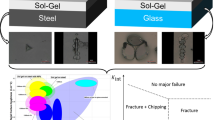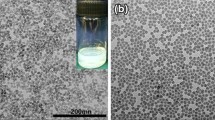Abstract
In this study, the mechanical properties and creep behavior of hybrid sol-gel silica-based coatings on copper substrates were investigated. Sol-gel processing was used to synthesize the organically modified silanes using mixtures of tetraethoxysilane and vinyltrimethoxysilane or glycidoxypropyltrimethoxysilane precursors. The mechanical and creep properties of the coatings were assessed using nanoindentation. The link between film structure and creep behavior from nanoindentation experiments was examined, and simple mechanical models were used to extract Young’s modulus and viscosity from fits to creep data. It is shown that the creep response of the coatings was influenced dramatically by the chain length and amount of organic substituent.











Similar content being viewed by others
References
J.D. Mackenzie: Structures and properties of ormosils. J. Sol-Gel Sci. Technol. 2, 81 1994
H. Schmidt: New type of non-crystalline solids between inorganic and organic materials. J. Non-Cryst. Solids 73, 681 1985
J. Wen G.L. Wilkes: Organic/inorganic hybrid network materials by the sol-gel approach. Chem. Mater. 8, 1667 1996
J. Wen, V.J. Vasudevan G.L. Wilkes: Abrasion resistant inorganic/organic coating materials prepared by the sol-gel method. J. Sol-Gel Sci. Technol. 5, 115 1995
K-H. Haas H. Wolter: Synthesis, properties and applications of inorganic–organic copolymers (ORMOCER®s). Curr. Opin. Solid State Mater. Sci. 4, 571 1999
T.L. Metroke, R.L. Parkhill E.T. Knobbe: Passivation of metal alloys using sol-gel-derived materials—A review. Prog. Org. Coat. 41, 233 2001
C. Sanchez, B. Lebeau, F. Ribot M. In: Molecular design of sol-gel derived hybrid organic–inorganic nanocomposites. J. Sol-Gel Sci. Technol. 19, 31 2000
J.D. Mackenzie E. Bescher: Some factors governing the coating of organic polymers by sol-gel derived hybrid materials. J. Sol-Gel Sci. Technol. 27, 7 2003
B.A. Latella, M. Ignat, C.J. Barbé, D.J. Cassidy J.R. Bartlett: Adhesion behaviour of organically-modified silicate coatings on stainless steel. J. Sol-Gel Sci. Technol. 26, 765 2003
B.A. Latella, M. Ignat, C.J. Barbé, D.J. Cassidy H. Li: Cracking and decohesion of sol-gel hybrid coatings on metallic substrates. J. Sol-Gel Sci. Technol. 31, 143 2004
A.J. Atanacio, B.A. Latella, C.J. Barbé M.V. Swain: Mechanical properties and adhesion characteristics of hybrid sol–gel thin films. Surf. Coat. Technol. 192, 354 2005
M. Ignat, T. Marieb, H. Fujimoto P.A. Flinn: Mechanical behaviour of submicron multilayers submitted to microtensile experiments. Thin Solid Films 353, 201 1999
B.A. Latella, B.K. Gan, K.E. Davies, D.R. McKenzie D.G. McCulloch: Titanium nitride/vanadium nitride alloy coatings: Mechanical properties and adhesion characteristics. Surf. Coat. Technol. 200, 3605 2006
B.A. Latella, G. Triani, Z. Zhang, K.T. Short, J.R. Bartlett M. Ignat: Enhanced adhesion of atomic layer deposited titania on polycarbonate substrates. Thin Solid Films 515, 3138 2007
M. Sakai: Time-dependent viscoelastic relation between load and penetration for an axisymmetric indenter. Philos. Mag. A 82, 1841 2002
S. Yang, Y-W. Zhang K.Y. Zeng: Analysis of nanoindentation creep for polymeric materials. J. Appl. Phys. 95, 3655 2004
C.Y. Zhang, Y.W. Zhang K.Y. Zeng: Extracting the mechanical properties of a viscoelastic polymeric film on a hard elastic substrate. J. Mater. Res. 19, 3053 2004
B. Beake: Modelling indentation creep of polymers: A phenomenological approach. J. Phys. D: Appl. Phys. 39, 4478 2006
M.L. Oyen: Sensitivity of polymer nanoindentation creep measurements to experimental variables. Acta Mater. 55, 3633 2007
I. Horcas, R. Fernández, J.M. Gómez-Rodríguez, J. Colchero, J. Gómez-Herrero A.M. Baro: WSXM: A software for scanning probe microscopy and a tool for nanotechnology. Rev. Sci. Instrum. 78, 013705 2007
J.S. Field M.V. Swain: A simple predictive model for spherical indentation. J. Mater. Res. 8, 297 1993
Y-G. Jung, B.R. Lawn, M. Martyniuk, H. Huang X.Z. Hu: Evaluation of elastic modulus and hardness of thin films by nanoindentation. J. Mater. Res. 19, 3076 2004
D.R. Bland: Theory of Linear Viscoelasticity Pergamon Oxford, UK 1960
A.C. Fischer-Cripps: A simple phenomenological approach to nanoindentation creep. Mater. Sci. Eng., A 385, 74 2004
E.H. Lee J.R.M. Radok: The contact problems for viscoelastic bodies. J. Appl. Mech. 27, 438 1960
M.V.R. Kumar R. Narasimhan: Analysis of spherical indentation of linear viscoelastic materials. Curr. Sci. 87, 1088 2004
P. Berthoud, C.G. Sell J-M. Hiver: Elastic-plastic indentation creep of glassy poly(methyl methacrylate) and polystyrene: Characterization using uniaxial compression and indentation tests. J. Phys. D: Appl. Phys. 32, 2923 1999
T. Chudoba F. Richter: Investigation of creep behaviour under load during indentation experiments and its influence on hardness and modulus results. Surf. Coat. Technol. 148, 191 2001
P. Innocenzi, G. Brusatin F. Babonneau: Competitive polymerization between organic and inorganic networks in hybrid materials. Chem. Mater. 12, 3726 2000
Acknowledgment
Thanks to G. Smith for assistance with polishing the Cu substrates.
Author information
Authors and Affiliations
Corresponding author
Rights and permissions
About this article
Cite this article
Latella, B.A., Gan, B.K., Barbé, C.J. et al. Nanoindentation hardness, Young’s modulus, and creep behavior of organic–inorganic silica-based sol-gel thin films on copper. Journal of Materials Research 23, 2357–2365 (2008). https://doi.org/10.1557/jmr.2008.0315
Received:
Accepted:
Published:
Issue Date:
DOI: https://doi.org/10.1557/jmr.2008.0315




